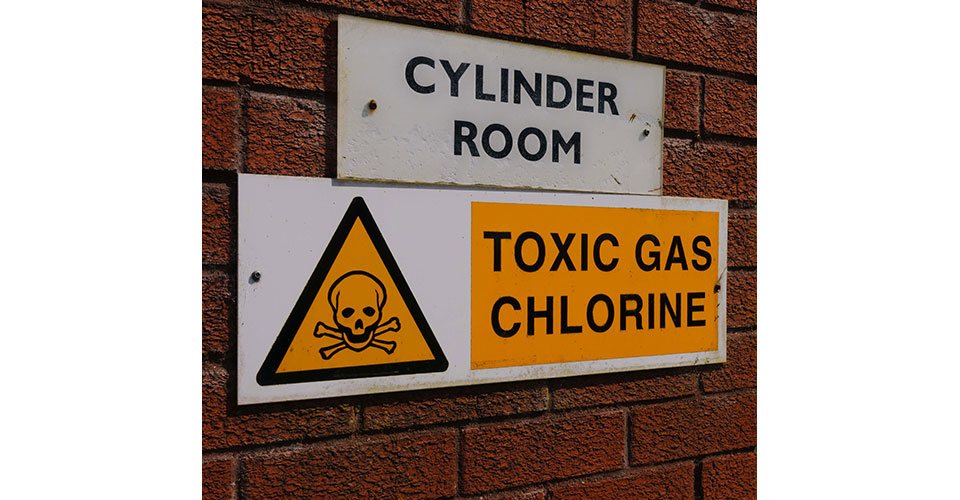Coming Clean on Chlorine Safety
- By : PureAire Monitoring Systems
- Posted on : January 28, 2022
- News Room
What is chlorine?
Chlorine gas (Cl2) is a dense, yellow-green gas that has a distinctive, irritating odor that is similar to bleach and is almost instantly noticeable even at very low concentrations. While Cl2 is not flammable, it may react explosively when exposed to other gases, including acetylene, ether, ammonia, natural gas, and hydrogen, among others. Due to its reactivity, chlorine is rarely used in its pure form but instead is typically combined with other elements.
If you have ever taken a dip in a swimming pool, you are more than likely familiar with chlorine and its distinctive odor, as well as the burning sensation that sometimes affects the eyes. Chlorine is widely used as a disinfectant in swimming pools and in a variety of residential and industrial cleaning solutions, as well as in many everyday products.
Applications and Benefits of Chlorine Use
Chlorine gas is commonly used in water and wastewater treatment facilities to disinfect water and kill contaminants, thereby helping to prevent water-borne diseases such as cholera, typhoid fever, dysentery, and hepatitis A. In the same way, many people use chlorine bleach to disinfect and whiten laundry, as well as on household surfaces to kill germs such as norovirus, E.coli, salmonella, and other pathogens.
In addition to its disinfectant properties, Cl2 is used in a variety of applications by a large number of industries. For instance:
- The automobile industry utilizes chlorine in the manufacture of seat cushions and covers, headlamp lenses, tire cord, bumpers, sealants, paint, fan belts, airbags, brake fluids, and navigation systems.
- Pharmaceutical manufacturers utilize chlorine in the production of medicines such as pain relievers, allergy medications, and drugs to help lower cholesterol.
- Many industrial solvents, dyes, plastics, epoxy resins, and synthetic rubbers (such as neoprene), use chlorine in their manufacturing processes.
- The paper and textile industries use chlorine to bleach paper and textiles.
- Technology firms use chlorine in the production of a diverse array of goods, including microprocessors for smartphones and computers, pc boards, lasers, fiber optic cables, hybrid car batteries, satellite guidance systems, etc.
Chlorine Safety
Well-known to be potentially hazardous to health, chlorine was one of the first poison gases used as a weapon during World War I.
Contact with chlorine can severely irritate and burn the eyes and skin. Exposure can also cause headaches, dizziness, nausea, and vomiting.
At high concentrations, and with prolonged exposure, inhalation of chlorine can cause sore throat, wheezing, coughing, chest tightness, pulmonary edema, permanent lung damage, and even death. While chlorine’s strong odor can provide some warning of its presence, prolonged exposure to chlorine can desensitize one’s sense of smell, thereby reducing awareness of the exposure.
Monitoring Chlorine
According to The Occupational Safety and Health Administration, the permissible exposure level for chlorine is 1 part-per-million (ppm), which should not be exceeded at any time. Chlorine is considered to be immediately dangerous to life and health when exposure levels reach 10 ppm.
To detect, and protect against, risks emanating from excessive concentrations of chlorine, best practices include placing gas detection monitors (containing visual and audible alarms) in locations where Cl2 may accumulate. The gas detection system should continuously monitor the area and, if chlorine concentrations exceed the permissible exposure limit of 1.0 ppm, activate an alarm, turn off the chlorine at the source, and turn on the ventilation system.
PureAire’s Universal Gas Detector
 PureAire Monitoring Systems’ Universal Gas Detectors use “smart” sensor cell technology to continuously track levels of chlorine. The sensor cell is programmed to monitor for a specific gas (in this case, chlorine) and measurement range, as required by the user.
PureAire Monitoring Systems’ Universal Gas Detectors use “smart” sensor cell technology to continuously track levels of chlorine. The sensor cell is programmed to monitor for a specific gas (in this case, chlorine) and measurement range, as required by the user.
PureAire’s Universal Gas Detectors allow manufacturers to monitor chlorine levels before employee health is put at risk. In the event that Cl2 is elevated to an unsafe level, the Universal Gas Detector will set off an alarm that includes horns and flashing lights, alerting staff to vacate the affected area. At the same time, the monitor can be programmed to turn on the ventilation system.
The Universal Gas Detector’s easy-to-read screen makes it simple for employees to monitor chlorine gas levels at a glance, giving them peace of mind as they work with this useful but hazardous gas.



